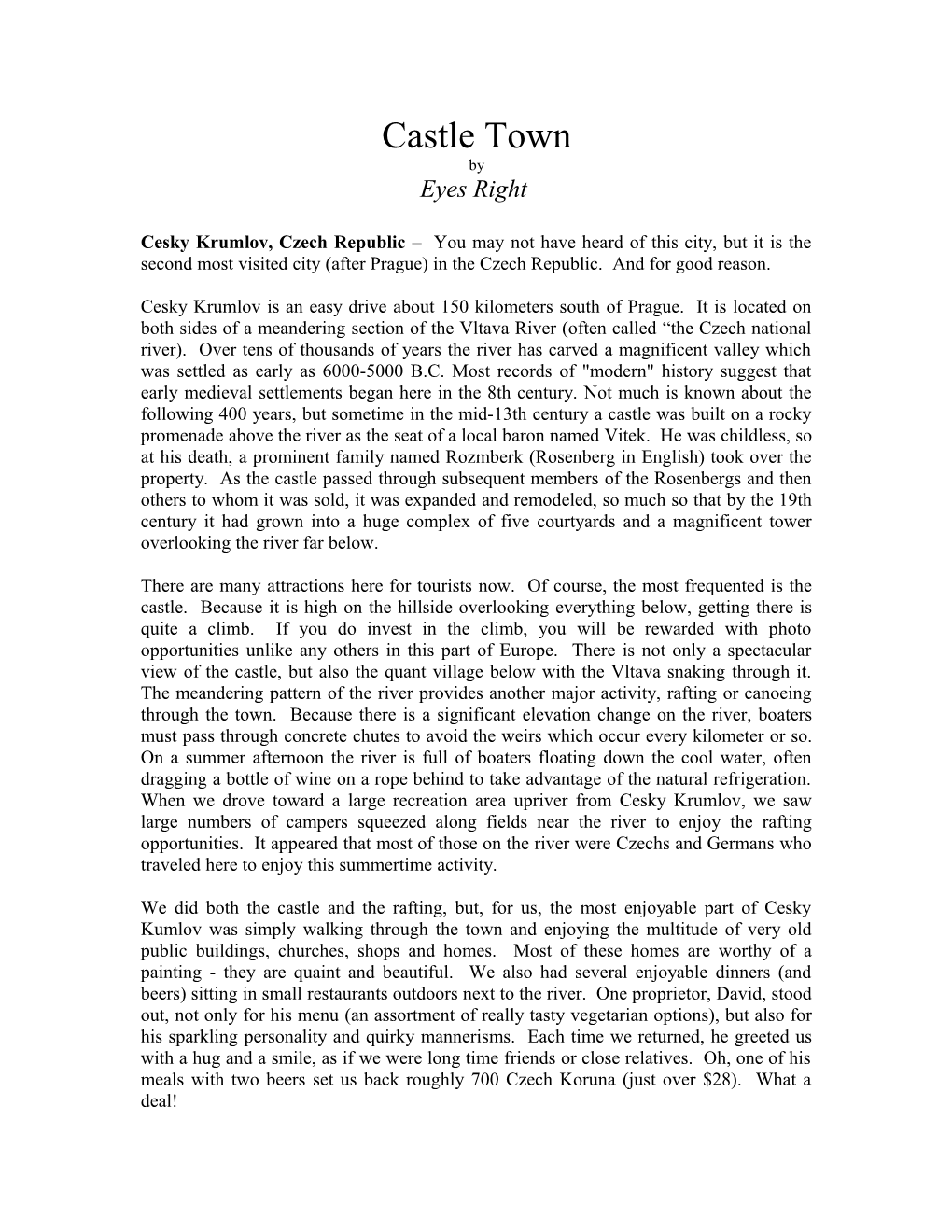Castle Town
by
Eyes Right
Cesky Krumlov, Czech Republic – You may not have heard of this city, but it is the second most visited city (after Prague) in the Czech Republic. And for good reason.
Cesky Krumlov is an easy drive about 150 kilometers south of Prague. It is located on both sides of a meandering section of the Vltava River (often called “the Czech national river). Over tens of thousands of years the river has carved a magnificent valley which was settled as early as 6000-5000 B.C. Most records of "modern" history suggest that early medieval settlements began here in the 8th century. Not much is known about the following 400 years, but sometime in the mid-13th century a castle was built on a rocky promenade above the river as the seat of a local baron named Vitek. He was childless, so at his death, a prominent family named Rozmberk (Rosenberg in English) took over the property. As the castle passed through subsequent members of the Rosenbergs and then others to whom it was sold, it was expanded and remodeled, so much so that by the 19th century it had grown into a huge complex of five courtyards and a magnificent tower overlooking the river far below.
There are many attractions here for tourists now. Of course, the most frequented is the castle. Because it is high on the hillside overlooking everything below, getting there is quite a climb. If you do invest in the climb, you will be rewarded with photo opportunities unlike any others in this part of Europe. There is not only a spectacular view of the castle, but also the quant village below with the Vltava snaking through it. The meandering pattern of the river provides another major activity, rafting or canoeing through the town. Because there is a significant elevation change on the river, boaters must pass through concrete chutes to avoid the weirs which occur every kilometer or so. On a summer afternoon the river is full of boaters floating down the cool water, often dragging a bottle of wine on a rope behind to take advantage of the natural refrigeration. When we drove toward a large recreation area upriver from Cesky Krumlov, we saw large numbers of campers squeezed along fields near the river to enjoy the rafting opportunities. It appeared that most of those on the river were Czechs and Germans who traveled here to enjoy this summertime activity.
We did both the castle and the rafting, but, for us, the most enjoyable part of Cesky Kumlov was simply walking through the town and enjoying the multitude of very old public buildings, churches, shops and homes. Most of these homes are worthy of a painting - they are quaint and beautiful. We also had several enjoyable dinners (and beers) sitting in small restaurants outdoors next to the river. One proprietor, David, stood out, not only for his menu (an assortment of really tasty vegetarian options), but also for his sparkling personality and quirky mannerisms. Each time we returned, he greeted us with a hug and a smile, as if we were long time friends or close relatives. Oh, one of his meals with two beers set us back roughly 700 Czech Koruna (just over $28). What a deal!
There are also numerous hiking opportunities in and around Cesky Krumlov, and plenty of shops to tempt you to part with your currency, no matter the type. In The downtown area, there are ATM machines about every 50 meters. Interestingly, although the Czech Republic is a member of the EEU, it has not adopted the euro as its currency, opting instead to retain its historic Koruna. Almost of the shops here are accustomed to working with the large number of tourists from all over Europe and overseas and will gladly take payment with your credit card. Many of the shops feature jewelry made from amber, garnet and moldavite (a green precious stone created by a meteor shower near here 20 million years ago and called vltavin by locals). The red garnet is mined in the Czech Republic, but the amber (a form of petrified tree sap) comes mostly from Eastern Europe. I looked at many of these beauties, but, other than one purchase, opted to spend my Koruna on gelato. In fact, once I calculated how many gelatos I could purchase over my lifetime for one piece of amber jewelry, those shopkeepers never had a chance.
I thought you might like to know.
E-R
